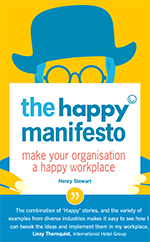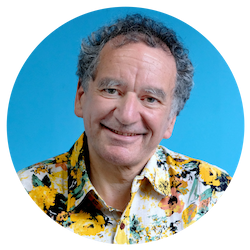Happy Workplaces are More Productive and More Profitable
New research has backed up one of the core principles at Happy. A happy workplace – where employees feel valued and satisfied, leads to better performance and better results.
This blog highlights this research and explains what the results show us about creating a successful working environment.
Hi, we are Happy
We are leading a movement to create happy, empowered and productive workplaces.
How can we help you and your people to find joy in at least 80% of your work?

Hanif Boustanifar and Young Dae Kang have just published the results of their analysis of the performance of the Fortune 100 Best Companies to Work For, going back to 1984.
The question they wanted to know was whether the companies that are listed in the Best Workplaces lists perform better.
They found that, when you look at the stock market prices, these companies have an excess return of between 2% and 2.7% a year compared to the standard stock market index.
That means that, over that 36 year period, the best workplaces would have performed over twice as well as the standard index.
That’s the difference between a pension of, say, £25,000 and one of £50,000.
That is the hard financial return that happy workplaces make.
This backs up the work of Alex Edmans, who back in 2011, studied the first 25 years of the Fortune 100 Best Companies to Work For and found an improved performance of between 2.3% and 3.8% (depending on the sector).
As the Great Place to Work Institute puts it “our data shows that building workplace trust is the best investment your company can make.”
There have been a wide range of these surveys. A Gallup study demonstrated that companies with highly engaged workforces outperform their peers by 147% in earnings per share.
A three year study of 41 global companies by Willis Tower Watson found “operating margins improved nearly 4% on average in organizations with high employee engagement levels and declined about 2% in those with low engagement levels.” They concluded that there is a “clear relationship between high levels of employee engagement and improved financial and operational results.”
So why don’t investment companies invest in happy workplaces?
Well there is one that does, the Parnassus Endeaver Fund. Jerome Dobson explains how he decided to create "a fund that only invested in organizations where employees were really happy", on the advice of the creator of the Best Companies to Work For list (the list used by Edmans for his analysis).
Set up in 2005 with just $600,000, the Fund now manages $4.8 billion, and was at one point rated in the top 1% of US investment funds for its ten year return. Its stated focus is clear: "The Parnassus Workplace Fund invests in companies with outstanding workplaces. The philosophy behind this fund is that companies whose employees love going to work will do better than companies with poor workplaces."
It is also true in the not-for-profits sector. Some years ago the Kings Fund did a study of UK hospitals, all of which have, at the request of the Department of Health, to carry out the same employee satisfaction survey.
The Kings Fund compared the survey results to a range of other factors, including patient mortality.
They found that, where staff are satisfied and happy, less people die. Where employee satisfaction was highest just 95.55 patients died, compared to 103 where employee satisfaction was lowest (standard mortality rate is 100).
That is the equivalent of 5,000 deaths a year. Or, as I like to put it, 5,000 lives saved by happy hospitals.
Companies that value employee satisfaction are simply more effective in every way. So if you want your organisation to be more productive, put a focus on employee satisfaction because happy staff lead to happy customers (or patients).
This is especially true at the moment, in the time of the “great resignation”. I carried out a brief LinkedIn survey to find out whether people were leaving even if the workplace was happy.
I found that for (self defined) non-happy workplaces 88% had people leaving. For happy workplaces, just 37% were leaving.
It makes sense. If you have a toxic workplace, people are going to leave – especially in current times. If instead you have a caring workplace, where people feel trusted, they are going to stay.
The evidence is clear. If you can create a happy workplace, where people feel satisfied with their work, then it will be more productive and less likely to have people leave. If you have people in your organisation who doubt it, show them the research.
And if you want to make a fortune, not just a decent pension, invest in happy workplaces.
Related blogs:
- Happy Staff are More Productive — Read about further research on this topic.
- The Key to being a Top Performer? Being Happy — This blog discusses how creating a Happy Workplace leads to success.
- 9 Benefits of Having Happy Employees — More reasons for increasing happiness in the workplace.
Keep informed about happy workplaces
Sign up to Henry's monthly Happy Manifesto newsletter, full of tips and inspiration to help you to create a happy, engaged workplace.

Learn the 10 core principles to create a happy and productive workplace in Henry Stewart's book, The Happy Manifesto.
Henry's Most Popular Blogs
- 8 Companies That Celebrate Mistakes
- 9 Benefits of Having Happy Employees
- 321Zero: How I Solved my Email Overload
- 16 Companies That Don't Have Managers
- 5 Big Companies Who Swear by Mindfulness
- 49 Steps to a Happy Workplace
- A Four Day Week? Let's Start With a Four Day August
- Google: Hire Great People and Give Them Lots of Autonomy
- Buurtzorg: No Managers, Just Great Care From a Nurse-Led Service
- 30 Steps to Joy at Work: Get More Done by Being Less Busy

Henry Stewart, Founder and Chief Happiness Officer
Henry is founder and Chief Happiness Officer of Happy Ltd, originally set up as Happy Computers in 1987. Inspired by Ricardo Semler’s book Maverick, he has built a company which has won multiple awards for some of the best customer service in the country and being one of the UK’s best places to work.
Henry was listed in the Guru Radar of the Thinkers 50 list of the most influential management thinkers in the world. "He is one of the thinkers who we believe will shape the future of business," explained list compiler Stuart Crainer.
His first book, Relax, was published in 2009. His second book, the Happy Manifesto, was published in 2013 and was short-listed for Business Book of the Year.
You can find Henry on LinkedIn and follow @happyhenry on Twitter.
Next Conference: 2025 Happy Workplaces Conference
Our Happy Workplaces Conference is our biggest event of the year, and we'd love for you to join us on Thursday 12th June!
This year's event will be held at Happy's HQ in Aldgate, central London.
We may also offer a hybrid option for people to join us online simultaneously — do let us know if you are interested in joining online and we can add you to the waiting list.
As always, our next conference will be filled with interaction, discussion and space for reflection.
Related courses
The Happy Leadership Programme
Brave Leadership: One-Year Leadership Development Programme for Women
Level 7 Senior Leadership Apprenticeship Programme
Not what you need? Take a look at all of our off-the-shelf Leadership and Management programmes.

